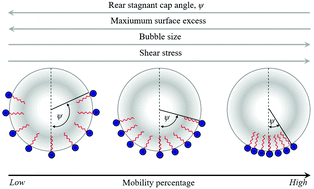Can small air bubbles probe very low frother concentration faster?†
Abstract
The existing literature on the rise velocities of air bubbles in aqueous surfactant solutions adsorbing at the water–air interface focuses mainly on large bubbles (D > 1.2 mm). In addition, due to the way the bubbles in rising bubble experiments are formed, their size is dependent on interfacial tension (the lower the interfacial tension the smaller the bubble). In this paper, smaller air bubbles (D < 505 ± 3 μm) are used to investigate the effect of the bubble size on the detection of two flotation frothers of different adsorption kinetics via bubble rise velocity measurements. We use an alternative method for bubble generation, allowing us to compare the rise velocity of bubbles of the same size in solutions of frothers of varying bulk concentration. The approach taken (ensuring consistent bubble size) ascertains that the buoyancy force component is kept constant when comparing the different solutions. As a consequence, any variations in the bubble rise velocity can be related to changes in the hydrodynamic drag force acting on a rising bubble. The interfacial behavior of frothers, i.e. the adsorption kinetics, interfacial activity and the maximum amount of molecules adsorbed at the interface, are determined from interfacial tension measurements and adsorption isotherms. The differences in the degree of tangential immobilisation caused by two different frothers are discussed in the context of differences in the structure of the dynamic adsorption layer, which is formed during the bubble rise.



 Please wait while we load your content...
Please wait while we load your content...